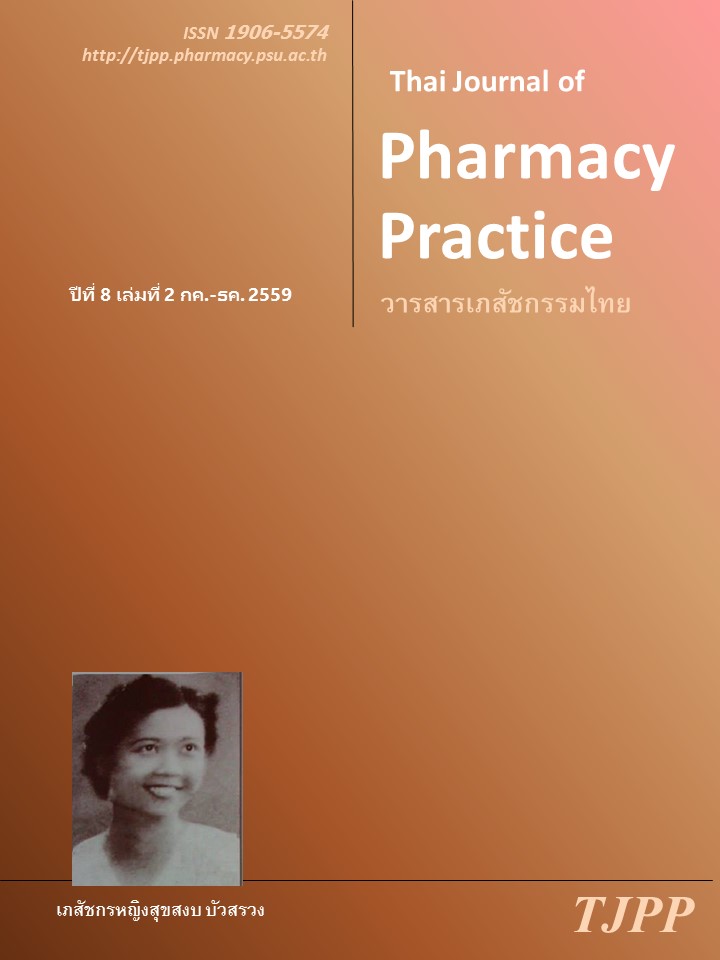ความชุกและการใช้ยาต้านจุลชีพของผู้ป่วยในที่มีประวัติแพ้ยากลุ่มเพนนิซิลิน
Main Article Content
บทคัดย่อ
วัตถุประสงค์:เพื่อศึกษาความชุกของผู้ป่วยในที่มีประวัติแพ้ยากลุ่มเพนนิซิลินและลักษณะการสั่งใช้ยาต้านจุลชีพในผู้ป่วยกลุ่มนี้ วิธีการ: งานวิจัยแบบภาคตัดขวางทำใน 3 หอผู้ป่วยได้แก่ ศัลยกรรม อายุรกรรม และ ออร์โทปิดิกส์ โดยใช้ข้อมูลจากฐานข้อมูลอิเล็กทรอนิกส์ของโรงพยาบาล ตั้งแต่เดือนมกราคมถึงธันวาคม พ.ศ. 2557 ณ โรงพยาบาลมหาราชนครเชียงใหม่ ผลการวิจัย: โดยรวม ผู้ป่วยใน 339 รายจากผู้ป่วยที่เข้ารับการรักษาทั้งหมด 28,025 ราย แจ้งว่า ตนเองมีประวัติแพ้ยากลุ่มเพนนิซิลิน คิดเป็นความชุกร้อยละ 1.2 (95%Cl 1.1,1.3) ผู้ที่แจ้งประวัติการแพ้ยา 194 ราย (ร้อยละ 57.2) เป็นเพศหญิง ผู้แพ้ยามีมัธยฐานของอายุ คือ 61 ปี (พิสัย 52-74) ผู้ป่วยที่แพ้ยามีอายุมากกว่า 60 ปีขึ้นไป 178 ราย (ร้อยละ 52.5) ยาที่มีการแจ้งประวัติแพ้มากที่สุดคือยา natural penicillins คือ 241 ครั้ง (ร้อยละ 69.7) อาการแพ้ยาที่พบมากที่สุด คือ การแสดงอาการแพ้ทางผิวหนัง (293 เหตุการณ์หรือร้อยละ 84.7) ยาต้านจุลชีพที่มีการใช้มากที่สุด 5 อันดับแรกในผู้ป่วยกลุ่มนี้ คือ cephalosporins (ร้อยละ 20.6) clindamycin (ร้อยละ 20.6) fluroquinolones (ร้อยละ 17.2) carbapenems (ร้อยละ 10.0) และ vancomycin (ร้อยละ 6.8) สรุปผล: ความชุกของผู้ป่วยในที่มีประวัติแพ้ยากลุ่มเพนนิซิลินอยู่ในระดับที่ค่อนข้างต่ำในโรงพยาบาลมหาราชนครเชียงใหม่ ลักษณะการใช้ยาต้านจุลชีพในผู้ป่วยกลุ่มนี้คล้ายกับที่รายงานในงานวิจัยอื่นที่ผ่านมา การบันทึกประวัติและอาการแพ้ยาอย่างละเอียดร่วมกับการปรึกษาผู้เชี่ยวชาญด้านภูมิแพ้และภูมิคุ้มกันจะช่วยเพิ่มความปลอดภัยในการใช้ยาต้านจุลชีพกลุ่ม β –lactam ในผู้ป่วยกลุ่มนี้และทำให้ผลลัพธ์ในการรักษาผู้ป่วยให้ดีขึ้น
Article Details
ผลการวิจัยและความคิดเห็นที่ปรากฏในบทความถือเป็นความคิดเห็นและอยู่ในความรับผิดชอบของผู้นิพนธ์ มิใช่ความเห็นหรือความรับผิดชอบของกองบรรณาธิการ หรือคณะเภสัชศาสตร์ มหาวิทยาลัยสงขลานครินทร์ ทั้งนี้ไม่รวมความผิดพลาดอันเกิดจากการพิมพ์ บทความที่ได้รับการเผยแพร่โดยวารสารเภสัชกรรมไทยถือเป็นสิทธิ์ของวารสารฯ
เอกสารอ้างอิง
2. TIMS (Thailand) Ltd. Mims annual. 27th ed. Bangkok: Ben Yeo; 2015.
3. Wright AJ. The penicillins. Mayo Clini Proc 1999; 74: 290-307.
4. Picard M, Begin P, Bouchard H, Cloutier J, Lacombe-Barrios J. Treatment of patients with a history of penicillin allergy in a large tertiary-care academic hospital. J Allergy Clin Immunol 2013; 1 : 252-7.
5. Lee CE, Zembower TR, Fotis MA, Postelnick MJ, Greenberger PA, Peterson LR, et al. The incidence of antimicrobial allergies in hospitalized patients: implications regarding prescribing patterns and emerging bacterial resistance. Arch Intern Med 2000; 160: 2819-22.
6. Borch JE, Andersen KE, Bindslev-Jensen C. The prevalence of suspected and challenge-verified penicillin allergy in a university hospital population. Basic Clin Pharmacol Toxicol 2006; 98: 357-62.
7. Kerr JR. Penicillin allergy : a study of incidence as reported by patients. Br J Clin Pract 1994; 48: 5-7.
8. MacLaughlin EJ, Saseen JJ, Malone DC. Costs of beta-lactam allergies: selection and costs of antibiotics for patients with a reported beta-lactam allergy. Arch Fam Med 2000; 9: 722-6.
9. Sade K, Holtzer I, Levo Y, Kivity S. The economic burden of antibiotic treatment of penicillin-allergic patients in internal medicine wards of a general tertiary care hospital. Clin Exp Allergy 2003; 33: 501–6.
10. Salkind AR, Cuddy PG, Foxworth JW. The rational clinical examination: is this patient allergic to penicillin? An evidence-based analysis of the likelihood of penicillin allergy. JAMA. 2001; 285: 2498–505.
11. Harris AD, Sauberman L, Kabbash L, Greineder DK, Samore MH. Penicillin skin testing: a way to optimize antibiotic utilization. Am J Med. 1999; 107: 166-8.
12. Gadde J, Spence M, Wheeler B, Adkinson NF Jr, Clinical experience with penicillin skin testing in a large inner-city STD clinic. JAMA 1993; 270: 2456-63.
13. Sogn DD, Evans R III, Shepherd GM, Casale TB, Condemi J, Greenberger PA, et al. Results of the National Institute of Allergy and Infectious Dis- eases Collaborative Clinical Trial to test the predictive value of skin testing with major and minor penicillin derivatives in hospitalized adults. Arch Intern Med 1992; 152: 1025-32.
14. Campagna JD, Bond MC, Schabelman E, Hayes BD. The use of cephalosporins in penicillin allergic patients. A literature review. J Emerg Med 2012; 42: 612-20.
15. Prematta T, Shah S, Ishmael FT. Physician approaches to beta-lactam use in patients with penicillin hypersensitivity. Allergy Asthma Proc 2012; 33: 145-51.
16. Kula B, Djordjevic G, Robinson JL. A systematic review: can one prescribe carbapenems to patients with IgE-mediated allergy to penicillins or cephalosporins? Clin Infect Dis 2014; 59:1113–22.
17. Jeffres MN, Narayan PP, Shuster JE, Scharmm GE. Consequences of avoiding β-lactam in patients with β-lactam allergies. J Allergy Clin Immunol 2015; 137: 1148-53.
18. Khasawneh FA, Slaton MA, Katzen SL et al. The prevalence and reliability of self reported penicillin allergy in a community hospital. Int. J. Gen. Med. 2013; 6: 905–9.
19. Macy E, Contreras R. Healthcare utilization and serious infection prevalence associated with penicillin “allergy” in hospitalized patients: a cohort study. J Allergy Clin Immunol 2014; 133: 790-6.
20. Suetrong N, Klaewsongkram J. The differences and similarities between allergists and non-allergists for penicillin allergy management. J Allergy (Cairo) 2014; 2014:214183. doi: 10.1155/ 2014/214183.
21. Lao-araya M. Allergy to beta-lactam antibiotics Chiang Mai Medical Journal 2014; 53: 183-209.
22. Park MA, McClimon BJ, Ferguson B, et al. Collaboration between allergists and pharmacists increases beta-lactam antibiotic prescriptions in patients with a history of penicillin allergy. Int Arch Allergy Immunol 2011; 154: 57–62.


